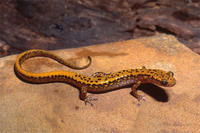LONGTAIL SALAMANDER

Adult Longtail Salamanders vary from 3.5 to 6 inches in length. The back and head are brownish yellow to bright yellow. Black spots occur on the animal's back and may be scattered in pattern or arranged in a double row. Frequently, the dark spots coalesce on the sides of the body to form a dark lateral stripe. The underside is dull white.
In Kansas, the Longtail Salamander is known only from the Ozark Plateau region of southeast Cherokee County where it is restricted to moist areas near streams, in or near caves, and under rocks and debris where moisture is suitable.

Longtail Salamanders are protected by the Kansas Nongame and Endangered Species Conservation Act and administrative regulations applicable thereto. Any time an eligible project is proposed that will impact the species' preferred habitats within its probable range, the project sponsor must contact the Ecological Services Section, Kansas Department of Wildlife, Parks and Tourism, 512 SE 25th Ave., Pratt, Kansas 67124-8174. Department personnel can then advise the project sponsor on permit requirements.
DESIGNATED CRITICAL HABITATSAs defined by Kansas Administrative Regulations, critical habitats include those areas documented as currently supporting self-sustaining population(s) of any threatened or endangered species of wildlife as well as those areas determined by the Kansas Department of Wildlife, Parks and Tourism to be essential for the conservation of any threatened or endangered species of wildlife.
Currently, the following areas are designated critical habitat for Longtail Salamanders:
All suitable wetlands, waters, and moist wooded bottom lands occurring within that portion of Cherokee County lying south and east of a line starting at the Kansas-Missouri border at Kansas Highway 96 in the SE 1/4 Sec. 12, T33S, R25E, then extending west along K-96 to its junction with Kansas Highway 26 at the NE corner Sec. 18, T33S, R25E, then south along K- 26 to its junction with U.S. Highway 66 at SE corner Sec. 18, T34S, R25E, then south and west along U.S. 66 to the Kansas-Oklahoma border at Sec. 14, T35S, R24E.







